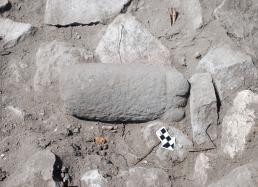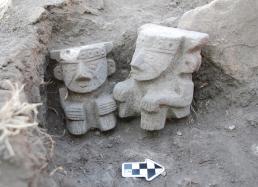4: The Stone Workers of Mitla
Buy a postcard of Mitla, and it's practically guaranteed to feature the elaborate cut stone facades that adorn the Postclassic palaces (ca. A.D. 1200) in the town’s archaeological zone (see above image.) The decorative facades of the Mitla palaces have long puzzled archaeologists. For while the greca-like designs depicted in the Mitla stone mosaics do have precursors on select decorative ceramic vessels from the region that pre-date the Postclassic-period palace facades, the practice of crafting intricate stone mosaics didn't seem to have a precedent.
Even at the great Valley of Oaxaca center of Monte Albán, which dominated the region for more than a millennium (ca. 500 B.C. to A.D. 750) before construction of the Mitla palaces, mosaic stone facades were absent. The renowned Mexican archaeologist Alfonso Caso proposed that perhaps Mitla was a Mixtec site because of the architectural differences with earlier Zapotec Monte Albán. In Caso’s time, Mixtec sites also were more known for their stone-working traditions than were sites in the valley. And yet, in Mitla today, most residents speak (and consider themselves to be) Zapotec, not Mixtec.
Over the years, other archaeologists have recognized the stylistic correspondences between the mosaic facades of Mitla and architectural traditions associated with the contemporaneous Puuc tradition in Yucatán. But while architectural parallels are evident, little has been done to document the necessary links or mechanisms through which the people of these two distant and different regions of ancient Mesoamerica may have communicated or interacted a thousand years ago.
In part, our understanding of the context of the stunning Mitla palace grecas has long been hampered by the limited information available on the villagers of the Mitla area prior to the construction of those palaces. Fortunately, this is starting to change with our 2009-2010 excavations at the Mitla Fortress site, where we've found both Late Classic and Postclassic period uses of the site.
During our 2009 studies, we observed that one of the principle occupations of households at the Fortress appeared to be stoneworking. This included making chipped stone tools using material from one of the Valley of Oaxaca’s better sources of chert, located at the base of the Fortress. But we also found rare amounts of exotic obsidian (volcanic glass), particularly in association with the later occupations of the site. In addition, we found a carved stone jaguar (see Photo #1 below) along with several stone artifacts (a spinning bowl and a spindle whorl), none of which we ever saw during ten seasons of excavation at El Palmillo.
One of our reasons in selecting Terrace 57 (adjacent to the terrace we dug in 2009) to excavate this year was to assess whether last year’s results could be supported with our new findings or not. In regard to the evidence for stone working, the correspondences could't be stronger. In addition to ample quantities of local chert tools and unusually large amounts of obsidian in the later levels, we also found a carved stone bat sculpted in the same style as last season’s jaguar. Plus, we found an unusual offering of two carved stone figures (see Photo #2 below) that appear to have been positioned together as part of a ritual of termination when the residential use of Terrace 57 ceased early in the Postclassic period.
Yet, perhaps the most telling indication of the Mitla inhabitant's stoneworking abilities came from the unusual stone facades that we found in two of the rooms that surrounded the Terrace 57 patio during the early stage of residential use, likely the Middle–Late Classic period. Significantly, these facades, although very simple compared to the later Mitla palaces, are mosaics fashioned of cut and shaped stone that define the entrance to rooms at least 500 years before the famous palace facades were constructed (see Photo #3 below.)
Terrace 57 is not a palace and so we wouldn't expect to find anything more elaborate than what we encountered. But the basis of a special and long-term relationship between the people of Mitla and stoneworking now seems clear, and the Postclassic palace mosaics have been provided a local historical context that does not require long-distance inspiration or influence.
Today, Mitla also is known for its weaving and cloth work, and our excavation findings indicate that this economic specialization may have a deep history at the Mitla Fortress as well. But there is little stoneworking in the community today beyond the dynamite quarrying conducted north of town, which yields only large gigantic blocks of stone for construction. Yet, a quick perusal of my library revealed that in the mid-20th century, more than 20 households made their livings in Mitla by carving stone into tourist art. Although this latter craft appears gone today, the stone carvers of the 1960s may have been the final artisans in what may been a tradition that endured for more than a millennium.
Word of the Day: piedra or “stone.”
More soon,
Gary





